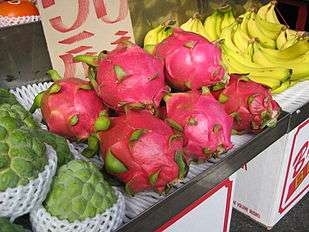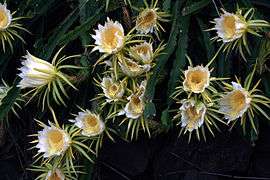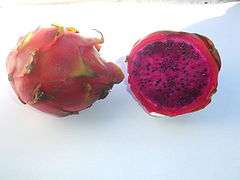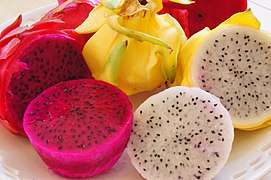Pitaya


A pitaya (/pɪˈtaɪ.ə/) or pitahaya (/ˌpɪtəˈhaɪ.ə/) is the fruit of several different cactus species indigenous to the Americas.[1][2] Pitaya usually refers to fruit of the genus Stenocereus, while pitahaya or dragon fruit refers to fruit of the genus Hylocereus, both in the Cactaceae family. The dragon fruit is cultivated in Southeast Asia, Florida, the Caribbean, Australia, and throughout tropical and subtropical world regions.
Vernacular names of Hylocereus
These fruits are commonly known in English as "dragon fruit", reflecting its vernacular Asian names. The names pitahaya and pitaya derive from Mexico, and pitaya roja in Central America and northern South America, possibly relating to pitahaya for names of tall cacti species with flowering fruit.[2][3] In Chinese, the fruit is referred to as huǒlóng guǒ (火龍果), literally 'fire dragon fruit'.[4]
Geography
Pitahaya-producing cacti of the genus Hylocereus, originally native to a region including Mexico, Guatemala, Nicaragua, Costa Rica, El Salvador, and northern South America.[1][2] The dragon fruit is cultivated in Southeast Asia, Florida, the Caribbean, Australia, and throughout tropical and subtropical world regions.[1][2]
Varieties
Stenocereus
Stenocereus fruit (sour pitayas) are a variety that is commonly eaten in the arid regions of the Americas. They are more sour and refreshing, with juicier flesh and a stronger taste. The sour pitaya or pitaya agria (S. gummosus) in the Sonoran Desert has been an important food source for indigenous peoples of the Americas. The Seri people of northwestern Mexico still harvest the fruit, and call the plant ziix is ccapxl "thing whose fruit is sour". The fruit of related species, such as S. queretaroensis and the dagger cactus (S. griseus), are also locally important foods. The fruit of the organ pipe cactus (S. thurberi, called ool by the Seris) is the pitaya dulce "sweet pitaya". It still has a more tart aroma than Hylocereus fruit, described as somewhat reminiscent of watermelon; it has some uses in traditional medicine.
Dragon fruit Hylocereus
Sweet pitahayas come in three types, all with leathery, slightly leafy skin:
- Hylocereus undatus (Pitaya blanca or white-fleshed pitahaya) has pink-skinned fruit with white flesh. This is the most commonly seen "dragon fruit".
- Hylocereus costaricensis (Pitaya roja or red-fleshed pitahaya, also known as Hylocereus polyrhizus) has red-skinned fruit with red flesh.
- Hylocereus megalanthus (Pitaya amarilla or yellow pitahaya, also known as Selenicereus megalanthus) has yellow-skinned fruit with white flesh.
Early imports from Colombia to Australia were designated Hylocereus ocampensis (supposedly, the red fruit) and Cereus triangularis (supposedly, the yellow fruit). It is not quite certain to which species these taxa refer, though the former is probably the red pitaya.
The fruit normally weighs from 150 to 600 grams (5.3 to 21.2 oz); some may reach 1 kilogram (2.2 lb).
Cultivation
.jpg)
After thorough cleaning of the seeds from the pulp of the fruit, the seeds may be stored when dried. Ideally, the fruit is unblemished and overripe.
Seeds grow well in a compost or potting soil mix – even as a potted indoor plant. Pitaya cacti usually germinate after between 11 and 14 days after shallow planting. As they are cacti, overwatering is a concern for home growers. As their growth continues, these climbing plants will find something to climb on, which can involve putting aerial roots down from the branches in addition to the basal roots. Once the plant reaches a mature 10 pounds in weight, the plant may flower.
Commercial plantings can be done at high density with between 1100 and 1350 plants per hectare. Plants can take up to five years to come into full commercial production, at which stage yields of 20 to 30 tons per hectare can be expected.[5]
Pitaya flowers bloom overnight and usually wilt by the morning.[6] They rely on nocturnal pollinators such as bats or moths for fertilization. Self-fertilization will not produce fruit in some species, and while cross-breeding has resulted in several "self-fertile" varieties, cross-pollinating with a second plant species generally increases fruit set and quality. This limits the capability of home growers to produce the fruit. However, the plants can flower between three and six times in a year depending on growing conditions. Like other cacti, if a healthy piece of the stem is broken off, it may take root in soil and become its own plant.
The plants can endure temperatures up to 40 °C (104 °F) and very short periods of frost, but will not survive long exposure to freezing temperatures. The cacti thrive most in USDA zones 10–11, but may survive outdoors in zone 9a or 9b.[2][7]
Hylocereus has adapted to live in dry tropical climates with a moderate amount of rain. The dragon fruit sets on the cactus-like trees 30–50 days after flowering and can sometimes have 5-6 cycles of harvests per year. In numerous regions, it has escaped cultivation to become a weed and is classified as an invasive weed in some countries.[1]
Pests and diseases
Overwatering or excessive rainfall can cause the flowers to drop and fruit to rot. Also, extended over-watering can cause maturing fruit to split on the branch. Birds can be a nuisance. The bacterium Xanthomonas campestris causes the stems to rot. Dothiorella fungi can cause brown spots on the fruit, but this is not common. Other fungi known to infect pitaya include Botryosphaeria dothidea, Colletotrichum gloesporioides and Bipolaris cactivora.[8]
Characteristics
The fruit's texture is sometimes likened to that of the kiwifruit because of its black, crunchy seeds. The flesh is bland, mildly sweet and low in calories. The seeds have a nutty taste. The seeds are rich in lipids.[9] Dragon fruit is also used to flavor (and color) juices and alcoholic beverages, such as "Dragon's Blood Punch" and the "Dragotini".[10] The flowers can be eaten or steeped as tea.[11]
The red and purple colors of Hylocereus fruits are due to betacyanins, a family of pigments that includes betanin, the same substance that gives beets, Swiss chard, and amaranth their red color.[12][13]
| Nutritional value per 100 g (3.5 oz) | |
|---|---|
| Energy | 268 kcal (1,120 kJ) |
|
82.14 g | |
| Sugars | 82.14 g |
| Dietary fiber | 1.8 g |
|
3.57 g | |
| Vitamins | Quantity %DV† |
| Vitamin C |
11% 9.2 mg |
| Minerals | Quantity %DV† |
| Calcium |
11% 107 mg |
| Sodium |
3% 39 mg |
|
| |
| |
|
†Percentages are roughly approximated using US recommendations for adults. Source: USDA Nutrient Database | |
Nutrients
As the nutrient content of raw pitaya has not been thoroughly analyzed as of 2018, the US Department of Agriculture reports one limited entry from a manufacturer, showing that a 100 gram amount of pitaya contains 268 calories, 82% carbohydrates, 4% protein, and 11% of the Daily Value each for vitamin C and calcium (table).
Seed oils
The fatty acid compositions of two pitaya seed oils were determined as follows:[9]
| Hylocereus costaricensis (Red-fleshed pitaya) | Hylocereus undatus (White-fleshed pitaya) | |
|---|---|---|
| Myristic acid | 0.2% | 0.3% |
| Palmitic acid | 17.9% | 17.1% |
| Stearic acid | 5.49% | 4.37% |
| Palmitoleic acid | 0.91% | 0.61% |
| Oleic acid | 21.6% | 23.8% |
| Cis-vaccenic acid | 3.14% | 2.81% |
| Linoleic acid | 49.6% | 50.1% |
| Linolenic acid | 1.21% | 0.98% |
Gallery
 Nocturnal pitahaya flowers
Nocturnal pitahaya flowers White pitahaya Hylocereus undatus
White pitahaya Hylocereus undatus Yellow pitahaya Hylocereus megalanthus
Yellow pitahaya Hylocereus megalanthus ’Red pitahaya, Hylocereus costaricensis
’Red pitahaya, Hylocereus costaricensis Pitaya fruit in various colors
Pitaya fruit in various colors- Dress for a folk dance called Flor de Pitahaya "Pitahaya Flower" from Baja California Sur displayed at the Museo de Arte Popular in Mexico City
 pitaya fruit in Bangladesh.
pitaya fruit in Bangladesh.
See also
- List of culinary fruits
- Opuntia – prickly pear cacti with edible "cactus figs" or "tunas" fruit
References
- 1 2 3 4 "Hylocereus undatus (dragon fruit)". CABI. 3 January 2018. Retrieved 19 April 2018.
- 1 2 3 4 5 Morton JF (1987). "Strawberry pear; In: Fruits of warm climates". Center for New Crops & Plant Products, Purdue University, Department of Horticulture and Landscape Architecture, West Lafayette, Indiana. pp. 347–8. Archived from the original on 5 May 2016. Retrieved 8 April 2016.
- ↑ "Dragon fruit". National Library Board, Singapore Government. 2017. Archived from the original on 21 November 2016. Retrieved 19 March 2017.
- ↑ "Hylocereus polyrhizus". Edible Medicinal and Non-Medicinal Plants. Springer Science & Business Media. 2012. p. 643. ISBN 9789048186617. Archived from the original on 2017-11-18.
- ↑ "Dragon Fruit - Amorentia Sweet Dragon Fruit". Retrieved 2018-06-05.
- ↑ Boning, Charles R. (2006). Florida's Best Fruiting Plants: Native and Exotic Trees, Shrubs, and Vines. Sarasota, Florida: Pineapple Press, Inc. p. 185. ISBN 978-1-56164-372-1.
- ↑ Setzer, Kenneth (26 July 2014). "Dragon fruit surprisingly easy to grow". Miami Herald. Archived from the original on 20 March 2017. Retrieved 19 March 2017.
- ↑ Valencia-Botín, Alberto J.; Kokubu, Hirotaka; Ortíz-Hernández, Yolanda D. (2013). "A brief overview on pitahaya (Hylocereus spp.) diseases". Australasian Plant Pathology. 42 (4): 437–440. doi:10.1007/s13313-012-0193-8.
- 1 2 Ariffin AA, Bakar J, Tan CP, Rahman RA, Karim R, Loi CC (2008). "Essential fatty acids of pitaya (dragon fruit) seed oil". Food Chemistry. 114 (2): 561–564. doi:10.1016/j.foodchem.2008.09.108.
- ↑ Small, Ernest (2011). Top 100 Exotic Food Plants. CRC Press. p. 105. ISBN 9781439856888. Archived from the original on 18 November 2017. Retrieved 29 July 2017.
- ↑ K, Lim T. (2012). Edible Medicinal and Non-Medicinal Plants: Volume 1, Fruits. Springer Science & Business Media. p. 641. ISBN 9789048186617. Archived from the original on 18 November 2017. Retrieved 29 July 2017.
- ↑ O. P. S. Rebecca, A. N. Boyce and S. Chandran (2010), "Pigment identification and antioxidant properties of red dragon fruit (Hylocereus polyrhizus)" African Journal of Biotechnology, volume 9, issue 10, pages 1450-1454.
- ↑ C. S. Tang and M. H. Norziah (2007) "Stability of betacyanin pigments from red purple pitaya fruit (Hylocereus polyrhizus): Influence of pH, temperature, metal ions and ascorbic acid" Indonesian Journal of Chemistry, volume 7, issue 3, pages 327-331.
External links
